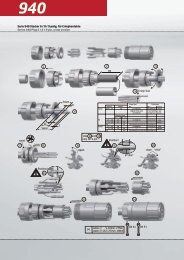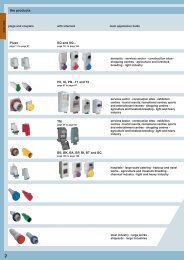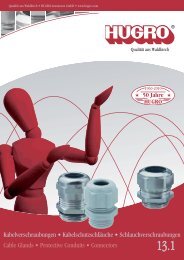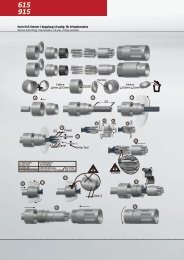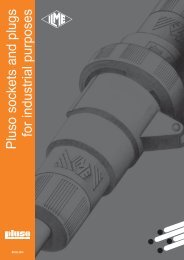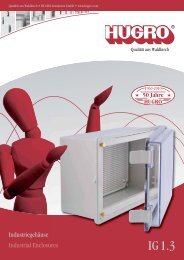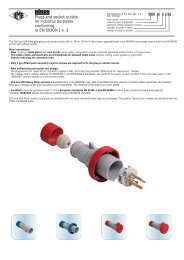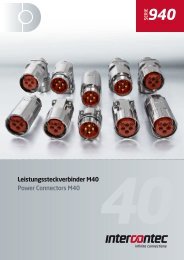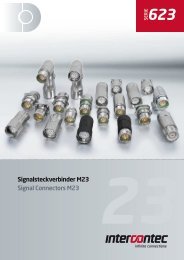CN07 Multipole Connectors - AP Technology
CN07 Multipole Connectors - AP Technology
CN07 Multipole Connectors - AP Technology
Create successful ePaper yourself
Turn your PDF publications into a flip-book with our unique Google optimized e-Paper software.
standards<br />
standards<br />
Dimensioning of clearances and creepage distances<br />
European standard EN 61984 Ed. 1.0 (22001-11) was recently published<br />
for safety prescriptions for multipole connectors for industrial uses and for<br />
the relevant tests. This standard assimilates, without any modifications, the<br />
corresponding international standard IEC 61984 Ed.1.0 (2001-06).<br />
It is applicable to connectors with rated voltage values of over 50V, and up<br />
to 1000V, and rated currents values of up to 125A per pole, for which no<br />
dedicated standard exists, or to which the particular specifications or the<br />
manufacturer refer as regards the safety aspects.<br />
For determining the minimum through-air and surface insulation distances,<br />
i.e. creepage distances, for connectors, this standard makes use (with some<br />
modifications) of the concepts of standard IEC 60664-1 Ed. 1.0 (1992-10) 1) .<br />
NOTE - For connectors with rated voltage values of up to 50V - excluded<br />
from the field of application of Low Voltage Directive 73/23/EEC - standard<br />
EN 61984 may be used as a guide. For surface and through-air insulation<br />
distances, refer to standard IEC 60664-1 Ed. (1992-10).<br />
We are illustrating below the method of standard EN 61984 for determining<br />
minimum insulation values in connectors. The rated characteristics for each<br />
ILME connector family are provided on pages 14 and 15.<br />
The following are now obsolete: the insulation group concept, and the<br />
distinction of rated voltage values into d.c. and a.c. voltage values 220V<br />
and 380V were adapted to standardised values 230V and 400V according<br />
to IEC 60038 (2) and some concepts were taken from the regulations for LV<br />
electrical systems of the IEC 60364 (3) series, as follows:<br />
- The overvoltage categories (I, II, III, IV), according to the use of the<br />
equipment (4) . They are correlated to the transient overvoltages taken as a<br />
basis for determining the rated impulse withstand voltage<br />
- The degrees of pollution<br />
- The classification of insulating materials according to their resistance to<br />
tracking<br />
- The conditions of the electrical field (homogenous or inhomogenous).<br />
Overvoltage categories (or impulse withstand)<br />
The overvoltage categories of a circuit or of an electrical system are<br />
identified by a conventional number (from I to IV) based on the limit or the<br />
control of the assumed transient overvoltage values obtained on a circuit or<br />
electrical system and depends on the means used to reduce the<br />
overvoltages.<br />
TABLE 1<br />
The rated impulse withstand voltage for equipment energised directly from<br />
the low-voltage mains (IEC 60664-1 Edition 1.0 1992-10)<br />
Nominal voltage of Voltage line to neutral Rated impulse withstand<br />
the supply system derived from nominal voltage b)<br />
based on IEC 60038 voltages a.c. or d.c.<br />
(CENELEC HD 472 S1, CEI 8-6)<br />
Overvoltage category<br />
V V ≤ V V<br />
Three phase a) Single phase I II III IV<br />
50 330 500 800 1500<br />
100 500 800 1500 2500<br />
120-240 150 800 1500 2500 4000<br />
230/400<br />
277/480<br />
} 300 1500 2500 4000 6000<br />
400 / 690 600 2500 4000 6000 8000<br />
1000 1000 4000 6000 8000 12000<br />
a) The "/" symbol indicates a four-wire three phase distribution system (star distribution).<br />
The lower value is the voltage between phase and neutral (phase voltage), whereas the<br />
higher value is the voltage between the phases (mains voltage).<br />
Where only one value is indicated, it refers to three-wire, three-phase systems (delta<br />
distribution) and specifies the line-to-line value.<br />
b) Equipment with these rated impulse withstand values can be used in installations in<br />
accordance with standard IEC 60364-4-443 (Italian standard CEI 64-8/4 Section 443, German<br />
standard DIN VDE 0100-443).<br />
Table 1 supplies the rated impulse withstand voltage for equipment energised<br />
directly from the low voltage mains in function of the rated voltage of the power<br />
supply system, the relative voltage line-to-neutral and the overvoltage category.<br />
Industrial machinery and installations with fixed connection to the low<br />
voltage supply system and consequently the relative components<br />
including multipole connectors, constitute an example of the equipment<br />
that belongs to the overvoltage category III.<br />
Examples of general equipment that comes under overvoltage category<br />
II are electrical household appliances, portable tools and other household<br />
equipment or similar.<br />
For distribution networks with rated voltage of 230/400V (star distribution with<br />
earthed neutral), and over-voltage category III (category III: impulse withstanding),<br />
the demanded rated impulse withstanding voltage is 4kV.<br />
For distribution networks with rated voltage of 400 or 500V (star distribution<br />
without neutral or with insulated neutral, or delta distribution, insulated or<br />
corner-earthed), and over-voltage category III (category III: impulse withstanding),<br />
the demanded rated impulse withstanding voltage is 6kV.<br />
(1) Assimilated with modifications as European Harmonisation Document HD 625.1 S1:1996<br />
and published by the CENELEC member countries as a national standard: Italian standard<br />
CEI 28-6 (1997-11), German standard DIN VDE 0110-1 (VDE 0110 Teil 1):1997-04.<br />
(2) Harminisation Document CENELEC HD 472 S1, Italian standard CEI 8-6, German<br />
standard DIN IEC 38:1987-05.<br />
(3) Italian standard CEI 64-8, German standard DIN VDE 0100.<br />
(4) HD 625.1 S1 modifies the definition to "impulse withstanding categories".<br />
Degrees of pollution<br />
Pollution indicates the presence of any kind of foreign matter, whether solid,<br />
liquid or gaseous (ionised gas) that can have a negative influence on the<br />
dielectric strength or on the surface resistivity of the insulating material.<br />
The standard establishes four degrees of pollution. The categories are<br />
identified by conventional numbers based on the quantity of polluting<br />
agents or on the frequency of the phenomenon which determines the<br />
reduction of the dielectric strength and/or of the surface resistivity.<br />
Pollution degree 1:<br />
No pollution or only dry, non-conductive pollution.<br />
The pollution has no influence.<br />
Pollution degree 2:<br />
Only non-conductive pollution except that occasionally a temporary<br />
conductivity caused by condensation may occur.<br />
Pollution degree 3:<br />
Conductive pollution or dry, non-conductive pollution which becomes<br />
conductive due to condensation which may occur.<br />
Pollution degree 4:<br />
The pollution generates persistent conductivity caused by conductive dust<br />
or by rain or snow.<br />
Pollution degree 3 is typical of an industrial environment or similar, while<br />
pollution degree 2 is typical of a household environment or similar.<br />
Standard EN 61984 permits the sizing of surface insulation distances of<br />
connectors installed in enclosures in protection class ≥IP54 for the degree<br />
of pollution immediately below that of the application environment (e.g.: 2<br />
instead of 3).<br />
Extract from standard EN 61984<br />
6.19.2.2 For a connector in protection class IP54 or higher, according to<br />
Publication IEC 60529, the insulating parts inside the enclosure may be<br />
sized for a lower degree of pollution.<br />
This applies also to coupled connectors, closure of which is ensured by the<br />
connector enclosure, and which may be uncoupled for test and maintenance<br />
purposes only.<br />
One may therefore use connectors installed in enclosures or containers in<br />
protection class ≥IP54, at the rated data referring to degree pollution 2 in<br />
industrial applications with degree of pollution 3, if, in compliance with the<br />
standard, the coupling of the connectors is opened only occasionally for<br />
tests or maintenance. In the event of temporary or limited duration in<br />
uncoupled state, a closing cover is, however, necessary, guaranteeing at<br />
least protection class IP54. However, this does not apply to connectors<br />
which remain uncoupled and exposed to an industrial atmosphere for an<br />
indefinite period. It should be noted, however, that pollution could penetrate<br />
inside coupled connectors, also when it comes from remote parts of the<br />
electrical system (e.g. through conduits providing cable entry to the<br />
connectors enclosure).<br />
Moreover, connector enclosures are usually supplied without cable entry<br />
devices, with the installer fitting such devices according to need. The<br />
degree of protection marked on the enclosures is guaranteed only for<br />
connectors coupled through the use of cable entry devices in equal or<br />
higher IP protection class and expertly installed.<br />
Examples of application for the selection of degree of pollution 2 for<br />
a connector<br />
- connector on an electric motor controller, which is uncoupled only to replace<br />
a faulty motor, also in cases where degree of pollution 3 is instead<br />
specified for the system;<br />
- connector on a module-constructed machine, which is opened only for<br />
transport purposes and which is used only for faster installation and for<br />
safer putting into service. One must make sure that the connector has not<br />
been polluted during transport. To ensure this has not occurred, protective<br />
covers or adequate packing must be used;<br />
- connector inside a panel in protection class ≥IP54. In this case one may<br />
even renounce equipping the connector with an IP54 enclosure.<br />
Insulating material<br />
Insulating material influences the determination of the minimum creepage<br />
distance. It is characterised according to the damage it suffers from the<br />
concentrated release of energy during scintillations when a surface leakage<br />
current is interrupted due to the drying of the contaminated surface.<br />
The CTI (comparative tracking index), (index of resistance to surface<br />
currents) is assumed as index of the resistance to creep currents of the<br />
insulating materials in the presence of atmospheric contaminating agents.<br />
The CTI constitutes the numeric value of the maximum voltage at which a<br />
material can resist against 50 drops of an electrolytic test solution without<br />
tracking, i.e. without a progressive formation of conductive paths on the<br />
surface of the solid insulating material (and permanent electric arc between<br />
the electrodes of the test equipment) due to the combined effect of<br />
electrical stress and electrolytic contamination.<br />
The solid insulating materials are classified into four groups:<br />
Group I 600 ≤ CTI<br />
Group II 400 ≤ CTI < 600<br />
Group IIIa 175 ≤ CTI < 400<br />
Group IIIb 100 ≤ CTI < 175<br />
The values for groups IIIa/IIIb (Table 6, EN 61984) are identical for the<br />
purpose of determining the creepage distance values.<br />
The insulating materials used to manufacture the ILME multipole<br />
connectors belong to groups IIIa / IIIb.<br />
10



